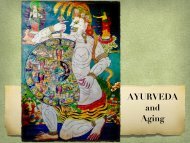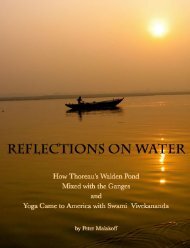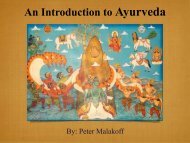How Thoreau's Walden Pond Mixed with the Ganges and Yoga Came to America with Swami Vivekananda
One early morning in 1846, during the coldest days of a New England winter, Henry David Thoreau looked out the window of his small cabin on Walden Pond and saw men cutting its ice into blocks. That ice was hauled by horse to a railroad that ran across the western edge of Walden Pond, packed into a boxcar, taken to Boston and loaded onto a clipper ship that sailed to Calcutta, India, arriving about four months later. Once there, that ice was purchased by grateful members of the East India Company. Thoreau had witnessed a small part of the global ice trade between New England and India that took place during the latter part of the nineteenth century. When Thoreau considered the ice trade, his vision sailed on metaphors far beyond the scope of business. The waters he imagined flowed both east and west and carried not just natural elements, but culture, religion and philosophy as well. He envisioned that after arriving in Calcutta, the New England ice of Walden Pond would eventually melt and run downhill where it would join with the sacred water of the Ganges. He wrote in Walden: "It appears that the sweltering inhabitants of Charleston and New Orleans, of Madras and Bombay and , drink at my well. In the morning I bathe my intellect in the stupendous and cosmogonal philosophy of the , since whose composition years of the gods have elapsed, and in comparison with which our modern world and its literature seem puny and trivial; and I doubt if that philosophy is not to be referred to a previous state of existence, so remote is its sublimity from our conceptions. I lay down the book [Bhagavad-Gita] and go to my well for water, and lo! there I meet the servant of the Bramin, priest of and and who still sits in his temple on the Ganges reading the , or dwells at the root of a tree with his crust and water jug. I meet his servant come to draw water for his master, and our buckets as it were grate together in the same well. The pure Walden water is mingled with the sacred water of the Ganges." This book tells the story of these waters . . .
One early morning in 1846, during the coldest days of a New England winter, Henry David Thoreau looked out the window of his small cabin on Walden Pond and saw men cutting its ice into blocks. That ice was hauled by horse to a railroad that ran across the western edge of Walden Pond, packed into a boxcar, taken to Boston and loaded onto a clipper ship that sailed to Calcutta, India, arriving about four months later. Once there, that ice was purchased by grateful members of the East India Company. Thoreau had witnessed a small part of the global ice trade between New England and India that took place during the latter part of the nineteenth century.
When Thoreau considered the ice trade, his vision sailed on metaphors far beyond the scope of business. The waters he imagined flowed both east and west and carried not just natural elements, but culture, religion and philosophy as well. He envisioned that after arriving in Calcutta, the New England ice of Walden Pond would eventually melt and run downhill where it would join with the sacred water of the Ganges. He wrote in Walden: "It appears that the sweltering inhabitants of Charleston and New Orleans, of Madras and Bombay and , drink at my well. In the morning I bathe my intellect in the stupendous and cosmogonal philosophy of the , since whose composition years of the gods have elapsed, and in comparison with which our modern world and its literature seem puny and trivial; and I doubt if that philosophy is not to be referred to a previous state of existence, so remote is its sublimity from our conceptions.
I lay down the book [Bhagavad-Gita] and go to my well for water, and lo! there I meet the servant of the Bramin, priest of and and who still sits in his temple on the Ganges reading the , or dwells at the root of a tree with his crust and water jug. I meet his servant come to draw water for his master, and our buckets as it were grate together in the same well. The pure Walden water is mingled with the sacred water of the Ganges."
This book tells the story of these waters . . .
You also want an ePaper? Increase the reach of your titles
YUMPU automatically turns print PDFs into web optimized ePapers that Google loves.
Realization<br />
To Realize <strong>the</strong> nature of Reality is Realization of God since in many Indian religious<br />
sects, God <strong>and</strong> Reality are <strong>the</strong> same. When <strong>the</strong> Realizer Realizes Reality<br />
that is what I refer <strong>to</strong> as Realization.<br />
Throughout this s<strong>to</strong>ry I have capitalized <strong>the</strong> words: Realization, Realized, Reality<br />
<strong>and</strong> Realizer. The Capitalization of <strong>the</strong>se four words is a literary device (Capitalization).<br />
I am using it <strong>to</strong> indicate something beyond what can be imagined or<br />
thought <strong>and</strong> indicate that <strong>the</strong> type of knowledge referred <strong>to</strong> here is unique <strong>and</strong><br />
distinct.<br />
The fundamental operating principle of <strong>the</strong> Vedic tradition is: whatever you<br />
meditate on, you become; in this way, <strong>the</strong> Realizer becomes <strong>the</strong> Realization. In<br />
<strong>the</strong> highest schools of <strong>the</strong> Indian tradition, subject <strong>and</strong> object, Realizer <strong>and</strong> what<br />
is Realized are ultimately one <strong>and</strong> <strong>the</strong> same or not two (advaita).<br />
These four words (Realizer, Realization, Reality, Realized) <strong>and</strong> <strong>the</strong> different<br />
ways <strong>the</strong>y can be interpreted, are found at <strong>the</strong> root of <strong>the</strong> varying philosophies<br />
of India as well as all <strong>the</strong> many religions <strong>and</strong> <strong>the</strong>ir sects. The possible<br />
meanings of <strong>the</strong>se few words are spokes that turn round <strong>the</strong> center of <strong>the</strong> various<br />
possible underst<strong>and</strong>ings about religion <strong>and</strong> God. Much is embodied in <strong>the</strong>se<br />
few words <strong>and</strong> <strong>the</strong> interpretations are many. Perhaps it all comes down <strong>to</strong> <strong>the</strong> different<br />
ways one can answer <strong>the</strong> following question: “Who is Realizing What?”<br />
Related Glossary Terms<br />
Advaita, Advaita Vedanta, God-Realization, God-Realizer, Identification, Paramahamsa, Reality,<br />
Realized, Realizer, Samadhi<br />
Index<br />
Find Term<br />
Chapter 1 - <strong>How</strong> <strong>Thoreau's</strong> <strong>Walden</strong> <strong>Pond</strong> <strong>Mixed</strong> <strong>with</strong> <strong>the</strong> <strong>Ganges</strong> <strong>and</strong> <strong>Yoga</strong> <strong>Came</strong> <strong>to</strong> <strong>America</strong> <strong>with</strong> <strong>Swami</strong> Viveka<br />
Chapter 2 - The Kashi Yatra, <strong>the</strong> Spiritual Master <strong>and</strong>!<strong>the</strong> Living Water of Life<br />
Chapter 2 - The Kashi Yatra, <strong>the</strong> Spiritual Master <strong>and</strong>!<strong>the</strong> Living Water of Life<br />
Chapter 2 - The Kashi Yatra, <strong>the</strong> Spiritual Master <strong>and</strong>!<strong>the</strong> Living Water of Life<br />
Chapter 2 - The Kashi Yatra, <strong>the</strong> Spiritual Master <strong>and</strong>!<strong>the</strong> Living Water of Life<br />
Chapter 2 - The Kashi Yatra, <strong>the</strong> Spiritual Master <strong>and</strong>!<strong>the</strong> Living Water of Life


















